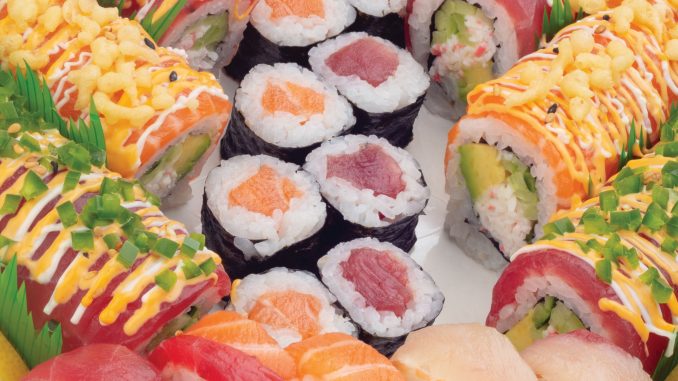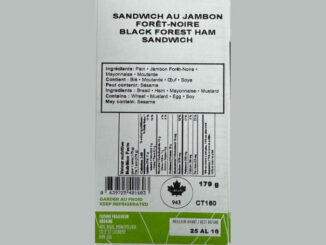
Carol M. Bareuther
Americans might not be as ready as their Japanese counterparts for robot-rolled sushi. Take the semi-automated conveyor-belt-style Sushiro restaurants based in Osaka, which New York-headquartered Baum+Whiteman International Restaurant Consultants calls a good example of its 2022 Trend of the Year—’The Robots Aren’t Coming. They’re here!’ At Sushiro, mere mortals work side by side machines to churn out, they claim, up to 1,500 dishes an hour. Most of this is sushi, with fried chicken and ramen dishes also, all in some 130 variations. For sushi, there is a row of rice-cooking robots in the back of the house with other machines that add the vinegar then mold the infused rice. Flesh-and-blood employees have only to add the crowning touch—a piece of hand-cut fish. What’s more, the artificial intelligence part of Sushiro’s system forecasts customer traffic and tells the flesh-and-blood staff which dishes to prepare next.
Robotically-made sushi is yet to be a widespread trend in the U.S. However, it’s no secret that Americans love sushi and have even made it their own. Case in point, California rolls with avocado, crab and cucumber, and Philadelphia rolls with smoked salmon, cream cheese and cucumber. Today, sushi is a $27.5 billion market, according to Sushi Restaurants in the US – Market Size 2005-2027, updated Dec. 29, 2021, by IBISWorld, with U.S. headquarters in New York City. This market size is expected to increase 23.9% in 2022.
What has changed the most with the pandemic is where shoppers are sourcing their sushi.
“As a result of the ongoing pandemic and the restaurant shutdowns that occurred, sushi lovers looked for alternate sushi sources. Even as restaurants have opened back up, we continued to see people buying their sushi from the grocery store, leading to a year of growth for us,” says Scot Schuman, general manager of sales and marketing for Torrance, CA-headquartered Advanced Fresh Concepts (AFC) Franchise Corp. AFC is the nation’s largest North America franchisor of supermarket-based foodservice counter concept centered on sushi and Asian fusion cuisine. “People have realized they can easily satisfy their sushi cravings by going to their local grocery store and purchasing delicious, quality sushi at an affordable price. There are tremendous opportunities ahead.”
Here’s how supermarket deli operators can assure sushi sales stay on a roll:
1. Choose a Format that Fits Best
There are opportunities and challenges in each of the three types of deli retail sushi programs: in-house store-made, sushi sourced through a supplier and an in-store self-contained sushi shop concept.
“One of our most successful programs is where a chef is making sushi on-site daily,” says Matt Connelly, business development associate for the Houston, TX-headquartered Snowfox Group/JFE Franchising, Inc., which manages more than 1,100 full-service sushi bars, including at supermarket chains like Kroger, and recently merged with three other powerhouse sushi companies from across the globe. “This gives customers comfort knowing that a chef is hand-making their sushi from fresh ingredients every day.”
Challenges include being labor-intensive, and if not part of a franchise system, the need for the deli operator to design and implement standard operating procedures and training programs and provide continuing oversight of operations.
“We also offer a direct-to-store delivery (DSD) program and a factory facility program. The DSD program is a great way to provide fresh sushi to a store that may not have the capabilities, or the volume, to have a chef on site. In this instance, a chef will prepare sushi at a full-service location and deliver to a participating DSD location. In our factory facility program, sushi is prepared at an offsite Snowfox facility and then delivered to a participating store. These factory facility programs feature an extended shelf-life product that preserves the freshness of the ingredients and rice. While these alternative programs are great for stores that may not be able to sustain a chef, there are disadvantages of not having a chef available onsite to be able to answer customer questions or provide sampling demos,” says Snowfox’s Connelly.
There are several pluses to having a franchised sushi program in-store, says Tracey Schram, vice president of sales and marketing for Fuji Food Products, Inc., in Santa Fe Springs, CA, which specializes in supermarket sushi programs. These are that the “chef is often the franchise owner, and he/she wants the program to be successful. The program is managed by a dedicated team, with quick response to all concerns and ensuring food safety protocols are followed. Continual innovation from an executive sushi chef, along with a team of highly-skilled and trained sushi chefs. Lastly, there is a guaranteed margin for the retailer. Most programs are a revenue split based on retail sales.”
2. Market & Menu a Selection
Millennials and Gen Z are primarily driving sushi trends, according to Schram. “These consumers have a high focus on health. They want Certified Sustainable Seafood, clean ingredients (no artificial colors, flavors, MSG, etc.), variety (cooked options, raw options, vegetarian options), fresh ingredients and convenience. Our best-selling types of sushi are combo packs, where there are a variety of rolls in one package. These packs are popular because they are shareable and provide an experience of different flavors and textures all in one package.”
Consumers across the U.S. are gravitating to fusion-style sushi rolls over the traditional nigiri.
“Among these fusion-style rolls, some of the most popular selling rolls are the ones containing our private brand crispy onions, which add a crunchy and savory texture to the rolls. Another popular roll is our New York Crunch roll, which contains avocado, surimi salad and cucumber and are topped with our spicy mayo, sushi sauce and crispy onions,” says Snowfox’s Connelly.
The bestselling type of sushi for AFC is uramaki, which means inside-out, says Schuman. “This is when the rice is on the outside and seaweed is on the inside versus more traditional Japanese rolls where the seaweed is on the outside. Our customers tend to enjoy our uramaki rolls with spicy mayo and savory sushi sauce drizzled on top. This style is popular because of the bold flavors the sauces provide, and the color and texture contrast of the various toppings and sauces on white sushi rice. Crab salad, avocado, tuna and salmon are the most popular ingredients.”
Fish- and meat-based offerings continue to be the mainstay of the sushi offerings. Yet, there has long been interest in vegetarian rolls and now plant-based options.
“Our innovation team has been working on new menu items featuring plant-based alternatives to seafood. The quality of these plant-based products has improved over the past couple of years,” says Fuji Food Products’ Schram.

3. Sell More
Customer engagement, ready and visible availability and promotion are all ways to sell more sushi.
“When it comes to a first-time sushi consumer, one of the most effective ways we have found to get them to buy sushi is through a simple conversation or sampling demo. This allows them to try our product without them having to worry about any financial commitment. Over the past two years, we eliminated sampling due to COVID-19 restrictions, but lately, depending on local regulations, some of our operations have returned to sampling demos. We have seen that since resuming sampling, new customers are engaging even more often and are more excited about trying our sushi,” says Snowfox’s Connelly.
Convenience, along with fast, timely service, is as paramount as ensuring that the sushi bar is noticeable, easy to get to and optimized for traffic flow to capitalize on in-store shoppers, adds AFC’s Schuman. “
Promotional campaigns designed to drive customer engagement can be profitable. For example, Snowfox recently offered a party platter promotion that gave customers a discount at participating locations.
The next horizon for supermarket sushi sales is e-commerce.
“We realize that e-commerce is a growing trend, and to stay competitive and reach this online, stay-at-home demographic, it is important that together with our grocery partners, we look into building a robust e-commerce platform,” says AFC’s Schuman. “Convenience, ease and accessibility at a reasonable price for all our consumers will be an undeniable future. Unlocking how to reach this demographic and convince people that our delivered sushi upholds its quality, will be key to continued growth.” DB



